“Barge of the Dead”
Written by Ronald D. Moore & Bryan Fuller
Directed by Mike Vejar
Season 6, Episode 3
Production episode 223
Original air date: October 6, 1999
Stardate: unknown
Captain’s log. Torres is coming in hot in a shuttlecraft that’s been damaged by an ion storm. She went out to retrieve their multispatial probe before it got hit by the storm. She manages to crash land in the shuttlebay and is taken to sickbay with a bad concussion.
Chakotay comes to her cabin with a piece of metal that’s about a hundred years old or so with the Klingon emblem on it. Apparently it collided with her shuttle when the deflectors went down, and it means that there was a Klingon presence in the Delta Quadrant some time in the past. Or, as Torres tartly points out, the Borg assimilated a Klingon ship in the Alpha Quadrant and dropped a piece of debris on the way back home.
Later, Torres sees blood coming out of the Klingon logo and hears voices speak in Klingon. She drags Kim into engineering to perform every possible test on it until three in the morning. Neelix interrupts by saying he’s holding a celebration in honor of this great discovery of Klingon archeology. Torres is less than enthused. (What Neelix is doing up at that hour is never explained.)
She meets with Tuvok for her meditation session, and Tuvok is much nastier and more critical than usual, and then he attacks her with a bat’leth and accuses her of dishonor.
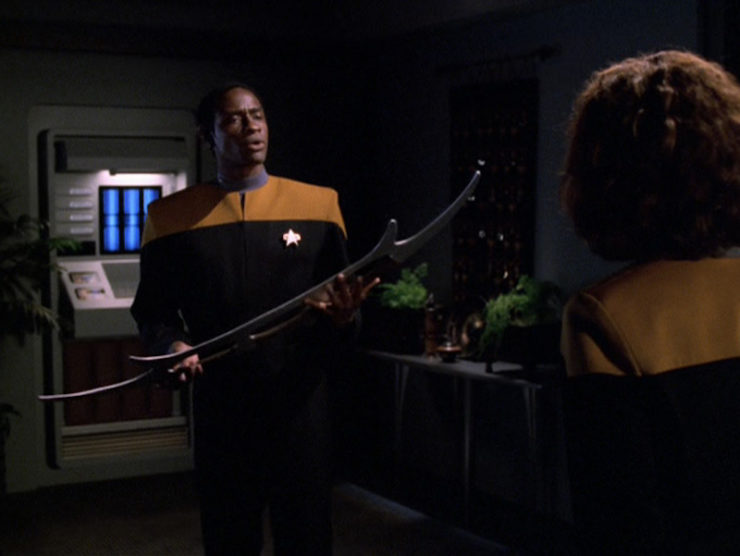
Neelix holds the party in the mess hall with lots of bloodwine and replicated gagh and other good stuff. While Janeway is giving a toast, time seems to slow down for Torres; the lights dim, and then a Klingon appears and kills the entire crew in front of her.
Then she finds herself on a boat: the Barge of the Dead, which sails across the River of Blood to bring the dishonored dead to Gre’thor. Torres is appalled to be told that she’s dead, though the shipmaster Kortar—the first Klingon, who killed the gods and was punished by being forced to ferry the dishonored dead across the River of Blood—tells her that he’s seen her once before when she was a child. She drowned, but was revived by her mother.
Another dishonored dead person boards the barge: it’s Torres’s mother Miral.
Then Torres wakes up in sickbay. Turns out her shuttlecraft was indeed damaged by an ion storm, but was adrift, and had to be tractored in. They found Torres comatose, and she only just now woke up from it.
However, Torres remains troubled by what happened while she was in the coma. She never used to believe in the Klingon myths Miral taught her when she was a child, but now she’s sorta-kinda experienced the afterlife. And now she thinks her mother might be dead and being sent to Klingon hell because the sins of the daughter are visited on the mother. Because Torres has been a pretty bad Klingon overall, Miral will have to suffer the torments of Gre’thor.
Torres wants to go back, to have the EMH re-create her near-death experience so that she can go back to the Barge and redeem Miral’s soul so she can go to Sto-Vo-Kor. She talks Janeway into letting her do it via a freedom-of-religion argument.
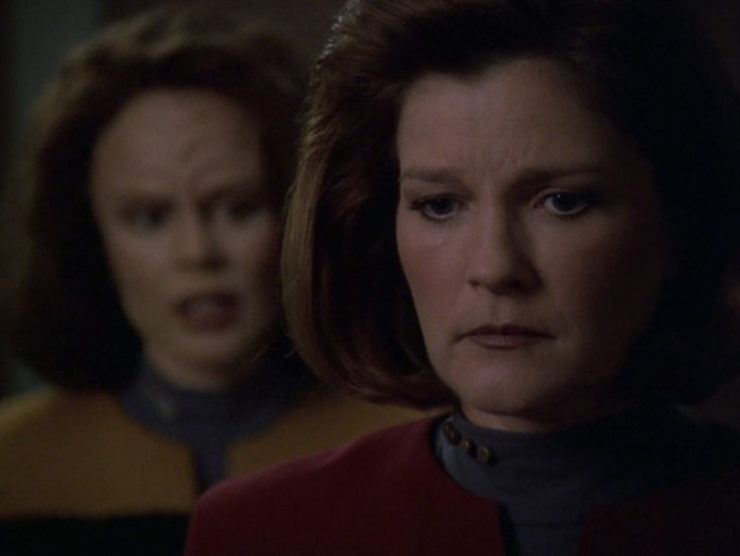
The EMH re-creates the atmospheric conditions of the ion storm and the shuttlecraft inside a force field in sickbay, which puts her into a coma. She finds herself back on the Barge, and tries to redeem Miral’s soul. Kortar dismisses her attempt, saying that she’s trying to use technology and trickery, because she isn’t really dead yet. So she commits to the bit, as it were, and accepts death and goes to Gre’thor in Miral’s place.
And then she winds up in Gre’thor itself—which is Voyager. She’s surrounded by versions of the crew who torment her. When Tuvok tries to attack her again, she rejects the entire thing, and finds herself back on the Barge—with Miral. Confused—she thought she freed Miral’s soul to Sto-Vo-Kor—Torres asks how to get out of this, finally realizing that she needs to stop fighting. She throws her bat’leth into the River of Blood, saying she’s tired of fighting all the time. Miral tells her that it’s the first step on her journey. She promises her daughter that she’ll see her again—in Sto-Vo-Kor, or perhaps when she gets home.
Torres finally wakes up in sickbay—to the relief of the EMH, Janeway, and Paris, whose attempts to revive her have all failed—and Torres immediately hugs Janeway.
Can’t we just reverse the polarity? Apparently, if you’re put in a coma from an ion storm, you go to the afterlife your mother’s culture believes in. Sure.
There’s coffee in that nebula! Janeway is convinced by Torres to be allowed to go into a coma, er, somehow. Also when Torres wakes up, she says, “Mother?” and then hugs Janeway, because she’s totally her space mom!
Mr. Vulcan. Tuvok is apparently still doing meditation sessions with Torres, as she hallucinates one, albeit one that goes very differently from the usual. (Tim Russ plays this scene more like the Klingon he played in DS9’s “Invasive Procedures.”)
Half and half. Torres first discusses her near-death experience with Chakotay, who advises her to slow her roll and take the time to interpret the vision. This is the same advice Chakotay gave Neelix in “Mortal Coil,” and he didn’t listen, either.
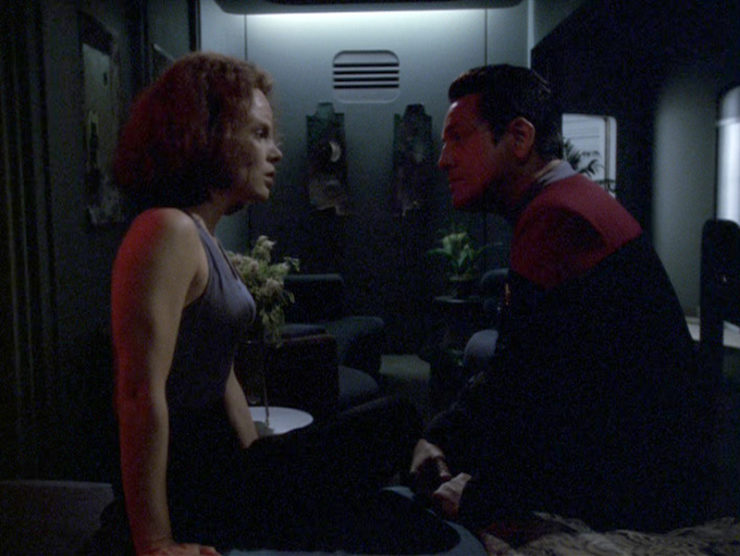
Everybody comes to Neelix’s. We never see the real Neelix, but one of the hallucinatory Neelixes serves as Torres’ tour guide aboard the Gre’thor version of Voyager, which is its own kind of hell. Another one reminds Torres that many great discoveries of the Klingon Empire happened by accident: for example, Sarpek the Fearless found the Knife of Kirrom when he was out looking for his lost targ…
Forever an ensign. A hallucinatory Kim is dragooned by Torres to study the Klingon metal fragment until three in the morning. He is not thrilled at the notion.
Please state the nature of the medical emergency. The EMH grows ever-more frustrated when everything he tries to revive Torres fails.
Resistance is futile. Because the producers apparently will never pass up an excuse to have Jeri Ryan and Robert Picardo sing duets, we get Seven and the EMH singing a Klingon drinking song, twice.
Do it.
“What do you want?”
“Who are you asking?”
“You! Kahless! The tooth fairy! Anybody who will tell me what I’m supposed to do!”
–Torres and Miral discussing philosophy and personal growth.
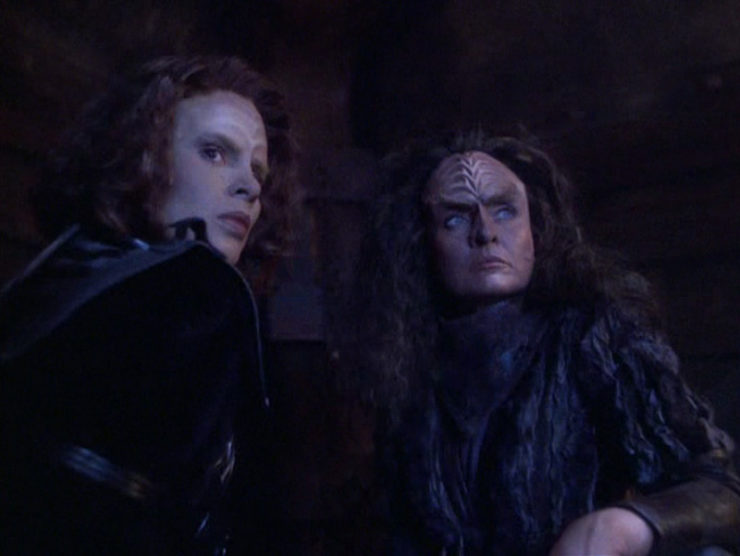
Welcome aboard. The great Eric Pierpoint plays his third of six Trek roles as Kortar, having played Voval in TNG’s “Liaisons” and Captain Sanders in DS9’s “For the Uniform.” He’ll have two roles in Enterprise, Shiraht in “Rogue Planet” and the recurring role of Harris in that show’s fourth season.
Karen Austin plays Miral; she was one of the finalists for the role of Janeway, and also played a doctor in DS9’s “Nor the Battle to the Strong.” Sherman Augustus and John Kenton Shull play various Klingons.
Trivial matters: This was a reworking of Ronald D. Moore’s original premise for “Soldiers of the Empire,” in which the Rotarran would go to the Klingon afterlife and Worf would see his father.
Gre’thor was established as the Klingon afterlife for the dishonored dead in TNG‘s “Devil’s Due.” Sto-Vo-Kor was established as the Klingon afterlife for the honored dead in TNG’s “Rightful Heir.”
That the Klingons killed their gods was established in DS9’s “Homefront.” Your humble rewatcher told a version of Kortar and his mate, Baka, killing the gods in The Klingon Art of War. Another version of the death of the gods was part of the wedding ceremony in DS9’s “You are Cordially Invited…”
This is the only mention of the Paq’batlh, though this could also be the sacred texts mentioned in TNG’s “Rightful Heir.”
The song that the EMH and Seven sing in Torres’s hallucination of the mess hall celebration is the same song that Worf and Huraga sang in DS9’s “The Way of the Warrior.”
The EMH tries cordrazine to revive Torres, a powerful stimulant first seen in the original series’ “The City on the Edge of Forever.”
Torres started doing meditation sessions with Tuvok in “Juggernaut.”
When Torres and Paris have a child in “Endgame,” she will be named Miral after Torres’s mother.
After Voyager returns home in “Endgame,” Torres spent a great deal of time in the novels Homecoming, The Farther Shore, Old Wounds, and Enemy of My Enemy, all by Christie Golden, seeking out her mother, finally finding Miral on Boreth, where she then died.
Just as Mark Lenard was cast as Spock’s father despite being only seven years older than Leonard Nimoy, and Cecily Adams cast as Quark’s mother despite being nine years younger than Armin Shimerman, Karen Austin was cast as Torres’ mother despite being only four years older than Roxann Dawson.
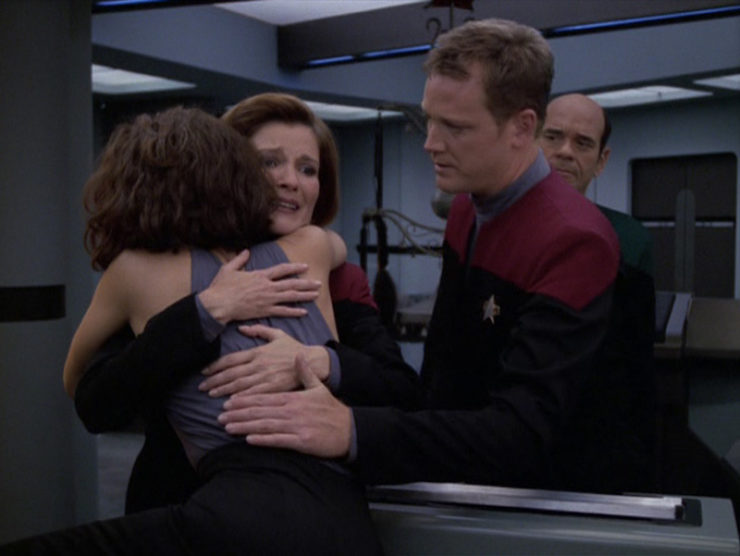
Set a course for home. “I don’t consider Voyager hell.” This could’ve been a great episode. The beginning and the end are excellent, a good character study of Torres, a nice progression of her character following the self-harm and depression of “Extreme Risk” and the anger-management problems in “Juggernaut.”
The problem is the bit in the middle. Star Trek has always come down on the rationalist side of things. Things that may have seemed supernatural have always, in the end, had some kind of scientific basis, whether the Prophets/wormhole aliens on DS9, the “magic” of Sylvia and Korob in the original series’ “Catspaw,” or the machinations of the red angel in Discovery’s second season. Visions and odd experiences and dreams have been experiences to be interpreted (“Birthright, Part I,” “Rightful Heir,” “Emissary,” “The Circle,” “Basics, Part I,” “The Fight,” etc.), and there’s never been any indication that supernatural phenomena exist.
Until this episode, where we’re explicitly told that there’s a Klingon afterlife. It makes no sense, otherwise, none, that Torres would have so linear and specific an experience both times she gets rendered comatose by an ion storm while in a shuttlecraft.
The last time the show dealt with the afterlife, it was a much more effective meditation on life after death, with Neelix being mostly dead instead of all dead in “Mortal Coil.” This one falls down because it’s not really about the Klingon afterlife, it’s about Torres letting go of her anger and longing for her mother—yet it does so in a way that explicitly states that the Klingon afterlife is real, and that just cuts off the air supply to my disbelief.
And the easy way around this, of course, is to have the whole thing be what Torres experiences while comatose with no interruptions. You can still use the rest of the cast in the hallucination, especially since we have that lovely notion that Voyager is also her own hell. There’s a lot to unpack there, and that’s a much more interesting theme to explore than to have Torres temporarily become an orthodox Klingon in order to justify going back into a near-death coma on purpose. Just keep her in the damn near-death experience the whole time, and have her come out of it when she has the catharsis with the image of her mother. You still could’ve done the character development without establishing that in the Star Trek universe, you can go to the specific afterlife of one of your parents’ cultural heritage just by waving some technobabble about.
Warp factor rating: 4
Keith R.A. DeCandido has written a ton of Star Trek work focused on Klingons, including the novels Diplomatic Implausibility, The Art of the Impossible, A Good Day to Die, Honor Bound, Enemy Territory, and A Burning House; the novella Enterprises of Great Pitch and Moment (part of the Slings and Arrows miniseries); the short stories “loDnI’pu’ vavpu’ je” (in Tales from the Captain’s Table), “Family Matters” (in Mirror Universe: Shards and Shadows), and “The Unhappy Ones” (in Seven Deadly Sins); the comic book Alien Spotlight: Klingons; and the reference work The Klingon Art of War. He also contributed to the Star Trek Adventures Klingon Empire Core Rulebook.











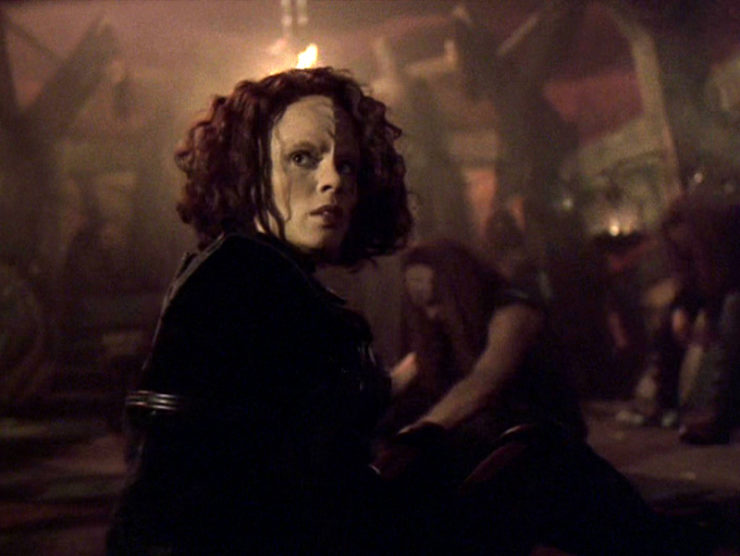
One other trivia note: The story credit makes this, as of now, Moore’s final contribution to the franchise.
I think the episode stayed ambiguous over whether what Torres experienced was real. It wasn’t until the Christie Golden novels that it was established that B’Elanna’s contact with her mother had actually happened and that Miral remembered it too, a decision I didn’t care for.
Still, this is a problematical episode. Even if it’s a hallucination, it’s unlikely that B’Elanna would have such a detailed hallucination of something from a cultural heritage she rejects. And the episode fails to explain why the Doctor would be okay with risking Torres’s life for this vision quest. I finally answered that in a scene in my Distant Shores story “Brief Candle,” which was a sequel to “Survival Instinct” but overlapped the events of this episode. Additionally, my story explains just what the multispatial probe was for and why retrieving it was so important, another thing the episode neglected to address.
Kortar being punished for an act that the Klingon wedding ceremony seemed to portray as positive (in a fairly grim, Klingon way) bothered me a bit, but I’m happy to put it down to cultural differences. Certainly there are enough different interpretations of how divine figures and the afterlife work even within a given subset of Earth religion, there’s no reason Belenna’s mother couldn’t belong to a particularly grim and unforgiving sect.
That said, I always read this as being more about an inner journey Torres needed to make using the mythical symbology of her youth rather than an actual venture into the afterlife, but that does require ignoring a Celestial Temple sized plot hole in the EMH’s ability and willingness to reinduce a near death experience.
(Not to encourage the show’s deeply flawed understanding of American Indian traditions, but surely this would have been a time to turn to Chakotay, with his experience in vision quests and altered states of being).
I think Chakotay’s response to Torres’ question about the afterlife is the line that Trek tries to walk. He said he believes there are things that scanners can’t pick up, which is a very political way to put it. It was somewhat surprising, too, as you would have thought that he had some kind of Native American belief (however made up it would have been).
I don’t think the episode presented what happened to Torres as a fact. I do concur, however, that it would have been best to have the whole episode be a hallucination rather than going through with the “put her in a coma and potentially kill her” bit.
@3/cuttlefishbenjamin:
That isn’t too different from the myth of Prometheus, who gave fire to humans (a good thing, at least for the humans) and was punished for it by being chained to a rock and having his liver eternally eaten by a bird. Mythology can be morally ambiguous.
Well, I thought the barge of the dead set was impressive. It sure looked expensive as well as all of the CGI going on around it.
The notion of Janeway as Torres’ space mom is rather cute and charming. It shows just how close the two have come in their six years together so far.
So we sort of meet Miral here and if this is actually how she is as the real Miral, I have a hard time seeing her and B’Elanna’s father as an actual couple, when we see him on his own in the 7th season episode “Lineage.”
It gets even weirder when one consider’s Janeway’s history of putting the good of the ship ahead of the rights of individuals to decide which medical procedures they should undergo.
@3/cuttlefishbenjamin: “Kortar being punished for an act that the Klingon wedding ceremony seemed to portray as positive (in a fairly grim, Klingon way) bothered me a bit”
Not unlike Prometheus, who was punished by the gods for giving fire to humans. It’s not an uncommon theme in mythology. Just because something benefits humans (or Klingons) doesn’t mean the divine forces of the universe approve of it.
There’s also something of a Christ analogy, Kortar being punished on behalf of his people, as the price for their redemption (or in this case, liberation from their gods).
Mr. Magic: I covered Moore’s brief Voyager stint pretty thoroughly last episode, didn’t see the need to repeat it here. :)
—Keith R.A. DeCandido
I have a soft spot for this one. It’s rare that we get Torres episodes that deal this directly with her Klingon heritage. I don’t think the episode ever makes a point on whether what she experiences is real or not. To me, being able to see the tension between B’Elanna and Miral is enough of an engine to power what I consider to be an excellent episode.
Death is very much an ongoing issue on Bryan Fuller’s doorstep, and using it as a catalyst to settle a main character’s emotional hangups with their closest relatives works well for me, especially when the show is cast this well. Not surprisingly, I also pretty taken with season 4’s Mortal Coil.
Plus, I like it that we get to see Gre’thor, whether its real or just a hallucination. If it is a hallucination, it’s a pretty good indication of how Torres views Klingon beliefs and what she considers to be the afterlife. And we get some great visuals to back that up.
Granted, the fact that the EMH so readily goes through with this is a sore point, but not enough to soil what is to me a welcome insight into the contentuous relationship between Torres and her mother.
@5/elcino 8/Christopher- Well, yes, but Prometheus got punished by the gods, whom Kortar had thoughtfully disposed of. I suppose we could infer a supradivine order of justice, in the same way that the Greek Gods dared not break oaths made on the River Styx.
@11/benjamin: Divine order/justice does not require anthropomorphic divinities. The karmic/reincarnation cycle in Hinduism and Buddhism and the Mandate of Heaven in Confucianism are forces of cosmic judgment or justice that operate like impersonal laws of nature rather than the whim of some micromanaging god. Indeed, in many world religions, even gods themselves are bound to follow certain cosmic rules dictating their rightful place in the scheme of things.
It seems self-evident that Klingon religion presumes some force that judges honor or dishonor and allocates fates accordingly. Since they believe their gods are dead, presumably they ascribe this to some intrinsic cosmic justice rather than a personified judge.
Mr. Magic: I covered Moore’s brief Voyager stint pretty thoroughly last episode, didn’t see the need to repeat it here. :)
Oh, yeah, heh, good point.
I remember I had mixed feelings about this episode at the time. After Worf’s presence on TNG and DS9, I think I was just sick of Klingon-centric episodes (even if this allowed more world building).
Kortor may have killed the Klingon Gods but there still seem to be divine or semi-divine figures even after the heavenly massacre. Recall that Fek’lhr is still seen as the ruler of Grethor and tormentor of dishonored souls.
There’s coffee in that nebula! Janeway is convinced by Torres to be allowed to go into a coma, er, somehow.
I really object to the way they did this– Janeway really shouldn’t go along with this, but if the script says she is, then she shouldn’t deny the request and then change her mind ten seconds later. Kind of blows her credibility when she’s allegedly made her decision on other matters. We’ll see almost the exact same thing in Virtuoso, where I’m definitely looking forward to the review but not the episode.
@13/Mr. Magic: Yeah… I think that when I saw this episode the first time, my reaction was more or less, “A Klingon episode by Ron Moore? Kinda typecasting himself there.”
I also was long ago burned out on Klingon lore-centric stories so it took me many years later to finally watch it on streaming. And then it was just “meh.”
@16/CLB: Yeah… I think that when I saw this episode the first time, my reaction was more or less, “A Klingon episode by Ron Moore? Kinda typecasting himself there.”
Eh, since the story was Moore’s final contribution to the franchise as of now, I suppose it was fitting he went out with the type of episode that was his Trek bread and butter.
It was at least interesting in, as Eduardo pointed out, Torres has always rejected her Klingon heritage (unlike Worf). It opened up storytelling avenues you couldn’t really have done with Worf (even in RDM’s original pitch for “Soldiers”).
@12, Christopher- Interesting… so you’re suggesting we could infer a supradivine order of justice?
@17, I was seriously burnt out on Klingon lore too. And what kills me is that it’s ALWAYS Kahless. In-universe I’m guessing he’s ironically a lot like IRL Romulus– the historical records are lost or sketchy so everything from that time period just gets attributed to him. But, still, Klingon lore would feel a lot richer if we knew more of their legendary figures or more events were set in a time period other than when Kahless was around. Kahless eventually died, surely some other Klingons did cool stuff too.
@20: Right. There are surely other eras of Klingon history worthy of exploration. For instance, I’m personally intrigued by how a warrior race made the leap to interstellar space travel. Did they hijack a Vulcan ship that landed on their home world like in “In A Mirror Darkly”? Or how about a story about a group of outcast Klingon pacifists? That would be fascinating. Too often Star Trek suffers from Planet of the Hats syndrome where every alien race has one singular culture.
@18/Mr. Magic: The show didn’t spend nearly enough time dealing with Torres’ aversion to Klingon society and customs. The Jeri Taylor-penned novel Pathways goes into quite a bit of detail of her childhood, including the time she was forced to meet for the first time her mother’s extended family on Kronos, which was its own bit of traumatic.
@21/garreth: Enterprise: “Judgment” will later reveal that the Klingon warrior caste only rose to dominate the Empire completely sometime within the previous century or thereabouts, and that before then it was just one of numerous castes. The other castes are still there, as they would have to be for a functional society to exist, but they aren’t esteemed as highly as warriors and are apparently excluded from political office. Since Trek nearly always focuses on Starfleet, we just see the parts of Klingon life that Starfleet interacts with, i.e. the military and government, so we rarely see non-warrior-caste Klingons aside from the odd scientist or lawyer.
As I recall, Keith addressed how the Klingons reached the stars in the history chapter he wrote for Modiphius’s Star Trek Adventures: The Klingon Empire Core Rulebook, and I think in one or two other works. Basically they reverse-engineered the tech the Hur’q left behind, rather than simply taking it for themselves like the Kazon did with Trabe ships.
@22/Eduardo: The later seasons pretty much ignored Pathways, and the B’Elanna episodes contradicted aspects of her backstory, for instance changing her mother’s name (it was Prabsa in the novel). I’m not sure how much can be reconciled between the two versions.
The later seasons pretty much ignored Pathways, and the B’Elanna episodes contradicted aspects of her backstory, for instance changing her mother’s name (it was Prabsa in the novel). I’m not sure how much can be reconciled between the two versions.
With Taylor’s retirement, I guess it was inevitable that whatever canonical cache it and Mosaic held in the Writers Room/EP Office would be diminished.
@21 The TNG episode “Birthright part 2” shows a group of Klingon pacifists.
Ba’el: “We’ve heard the stories all our lives. How people are slaughtered in terrible battles, forced to fight whether they want to or not. That’s why our parents came here, to make a safe home, a place where they could raise their children in peace.”
“I inherited the forehead and the bad attitude. That’s it.”
When this episode started, I was scratching my head a bit because I couldn’t remember anything about them finding an old Klingon ship. Then Torres started seeing blood coming out of the bulkhead and I realised it was a hallucination. I’m surprised how little I remembered about it: I thought there was a lot more of Torres on the titular barge of the dead and a lot more interaction between her and Miral than there actually was.
Maybe I was in the wrong mind to watch this, maybe our discussion on the last episode influenced me, but I didn’t enjoy this as much as I expected. Viewed in isolation, the production’s good, the acting’s superb (Roxann Dawson seriously knocks it out of the park here) and the writing’s fine if a bit too much style over substance. Viewed as part of an ongoing series, it showcases one of Voyager’s main problems: Too many characters with a single “hat” that forms the basis for most of their focus episodes. Harry Kim gets episodes about being an inexperienced junior officer…for seven years. Seven gets episodes about struggling to fit in on Voyager…for four years. Neelix gets several episodes exploring his grief over losing his family. And Torres episodes tend to be about the fact that she’s simultaneously resentful of her Klingon heritage and unable to control that side of her nature, leaving her at war with herself and the rest of the galaxy. We saw it first in “Faces”, we’ve seen it a number of times since and it’ll crop up again before the series concludes. To be fair, I guess this does add a bit of variety with the inclusion of Torres’ mother but it still feels like going over old ground.
So while, in a way, it’s good that we don’t get a definitive explanation for what Torres has gone through, this does feel more like an airing of her troubled subconscious than a spiritual experience or some higher power teaching her a lesson.
The hallucinatory Neelix’s introduction speech on Voyager echoes the one Stadi gave to Paris in “Caretaker”.
@23/CLB: Good to know, thanks. I still have yet to watch large swaths of Enterprise, especially the first three seasons so that accounts for a lot backstory I’m unfamiliar with.
To me, the issue of Torres’ backstory isn’t so much in the finer details. I can look past those, such as her mother’s name. Suffice to say, that the live-action will always be the reigning factor in terms of determining what’s canon, even though Mosaic and Pathways were as close to official as any Trek-based novel could get.
The details may be different, but I still feel Barge gets the essence of the Torres problem. Someone who spent her life running away from where she came from, and who’s now forced to confront that fear. I still saw a lot of that character trait on her Pathways backstory.
Since Trek nearly always focuses on Starfleet, we just see the parts of Klingon life that Starfleet interacts with, i.e. the military and government, so we rarely see non-warrior-caste Klingons aside from the odd scientist or lawyer.
Yeah, that was why I loved Keith’s IKS Gorkon finale A Burning House and how it was able to explore the other corners/industries of the Empire that you’d never see in a Starfleet-centric POV.
I didn’t see this episode as unambiguously stating that the Klingon afterlife was real. Even with the interruption, it is possible that the vision was a product of Torres deep-rooted beliefs which she rejected, but still had. Even so, I didn’t particularly like the episode for two reasons: first, I too was tired by Klingon episodes with HONOR in them, and second, the vision either was real, which I disliked for the same reasons as Keith, or it was all a dream, which is a trope I don’t really like.
I put it under the It Was All a Dream (Or Was It?) category, where a character has a subjective experience they may take as meaningful even if it’s nonsubjective reality remains in question.
I would say that one of Torres’ problems with her Klingon heritage is that she has some legitimate reasons to be angry. If she were a human kid with parents who had a messy split, kids who made fun of her for being different, and a mom who (understandably) was trying to pass on her culture to her when being like her mom was what got her rejected by the other kids, a school therapist whose only qualification was watching a lot of teen angst movies could probably figure out what was going on.
Instead, Torres seems to have had her anger dismissed as just a sign of being Klingon.
Being Klingon may make her more aggressive by nature, but that’s like acknowledging that one kid may get upset over problems while another may turn inward and become passive. It ignores why she’s angry.
But, this episode also taps into the other half of Klingon culture. Being a Klingon isn’t about being angry or aggressive. Torres has done all that. This episode also has Torres dealing with how her anger and her rejection of her culture has hurt her mother. The resolution, to stop fighting, is also about being a warrior. Ending conflict and being in control of her anger and fighting instincts is how she accepts what her mother tried to teach her.
But, the story would have made more sense if Torres decided to do something dangerous on her own to try get back to the death barge and contact her mother. Rather than deliberately nearly killing herself, maybe Torres took some ritual to a life-threatening extreme (like fasting while doing battle drills till she passes out or something).
On the Klingon Charion: The Klingong don’t worship their gods but they do seem to have ancestor worship and general worship of great warriors past. Maybe the the Klingon who killed the gods became the Judge of the Dead who takes souls to the afterlife and this was just one aspect of him. Or, maybe in her mother’s branch of the faith, he went from judge to judged.
Until this episode, where we’re explicitly told that there’s a Klingon afterlife. It makes no sense, otherwise, none, that Torres would have so linear and specific an experience both times she gets rendered comatose by an ion storm while in a shuttlecraft.
Sure it makes sense. It was a dream. It’s television’s ye olde recurring dream, which often pops up in sitcoms, but what the hey. It’s Voyager.
I’ll bet a targ to a gagh-worm that there’s at least one folkloric tradition where Kortar condemned himself to helm the Barge of the Dead – for who else would dare punish one who slew his own Gods? (If nothing else, there would be something operatic in one who slew his Gods in a fit of passion and condemned himself to suffer a Just punishment for that crime, so that his People might know that Gods or no Gods a Klingon that there must be consequences for those who break faith).
Ahem, “… so that his People might know that Gods or no Gods, a Klingon who breaks faith must suffer the consequences.”
As a Star Trek Online player the game follows this up. With the monks at Boreth being able to consistently induce visions to enter Gre’thor voluntarily, and even retrieve souls from it. Even fighting Fekhlr. I am also ambivalent about them actually actualizing the Klingon hell. On the other hand Kortar is an interesting figure treated with respect. While Kortar is the helmsman of the Barge of the Dead, he is not actually condemned to Gre’thor himself or considered dishonored. Instead he counsels Klingons that appear on the barge about not giving up. Considering the existence of the Black Fleet being an honorable place to be sent in the Klingon Afterlife alongside Sto’vokor, it seems that the River of Blood flows throughout the Klingon Afterlife and Kortar is ultimately just the oldest sailor of it.
One thing I find interesting is how it is Kahless who established the rules of honor and who waits in Stovokor, but it raises the question of what happened to the Klingons between Kortar and Kahless.
Terry Pratchett offered the idea that you get the afterlife you expect, good or bad, and so missionaries should be shot on sight so they can’t guilt you into spending half of eternity in the Great Dentist’s Waiting Room or whatever.
J. R. R. Tolkien gave different afterlives, implicitly, to different species: Elves die (technically, they don’t have to) and go to a broadly terrestrial “heaven” somewhere overseas. Nothing particularly stops them from getting on a boat and coming back, though it is against the rules and it was easier when the world was still flat. The natural or unnatural death of Men, humans, puzzles them.
Vulcans we know about: at death, their spirit possesses the nearest doctor… that’s going to be tricky on Voyager.
Torres might get permission for her induced near-death experience by bringing up her personal log of self-harm and suicide attempts after the Maquis catastrophe and arguing that she will do it anyway, so better that it’s in her free time. On the other hand, what’s to stop the Doctor offering a near-death experience but actually giving her LSD or something, besides TV broadcasting rules I suppose.
When she woke up in a strange place, her first instinct was to say, “Computer, end program”. Respect.
This must have been a common prank pulled at Starfleet Academy. At least I can see Tom and Harry doing it to each other many times over the course of the series.
I was expecting Torres’ mother to refer to her as Lana after the hallucinatory Janeway called her Lana at the beginning of the episode and Torres remarked that her mother called her that. As far as I can tell, though, she never did. Always sounded like she called her B’Elanna.
Boy, Klingons sure have it rough. Not only are children held accountable for the sins of their parents, but parents are held accountable for the sins of their children. Well, we know Worf is going to wind up in Gre’thor. 😂
Karen Austin portrayed the court clerk in the very first season of Night Court, where her name was, coincidentally, Lana.
I love the upside down Klingon emblem being the symbol of Gre’thor. I thought it was a simple, yet effective idea.
The whole time I was watching this I kept thinking that it was Trek doing Flatliners — a movie I’ve always had some affection for. An individual is put into near/partial death and then revived so they can battle their personal demons.
I don’t know that this episode succeeds wholly. I kept feeling it was poking at meaning here and there, but not really getting at anything. Sort of like this comment.